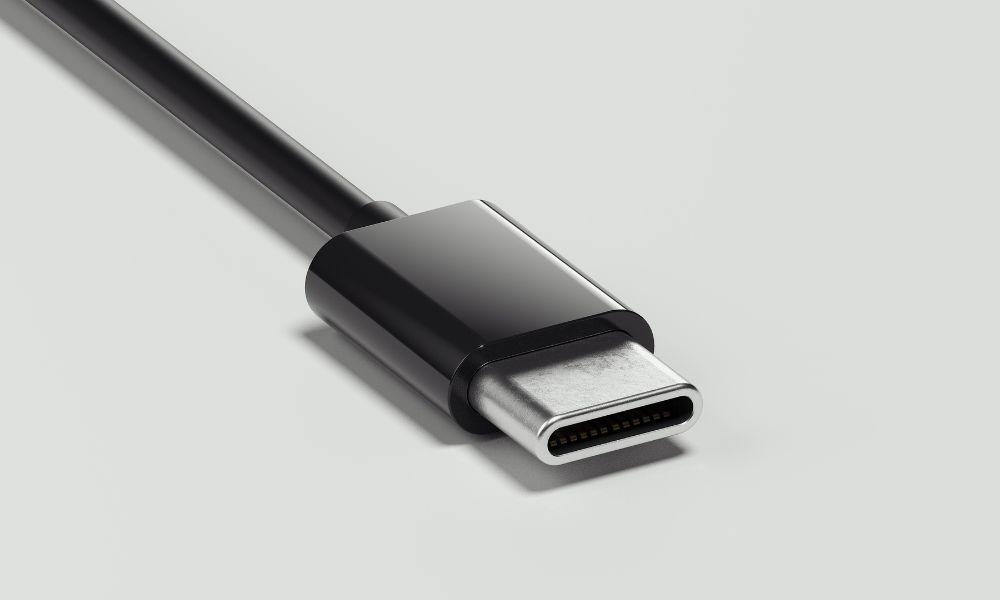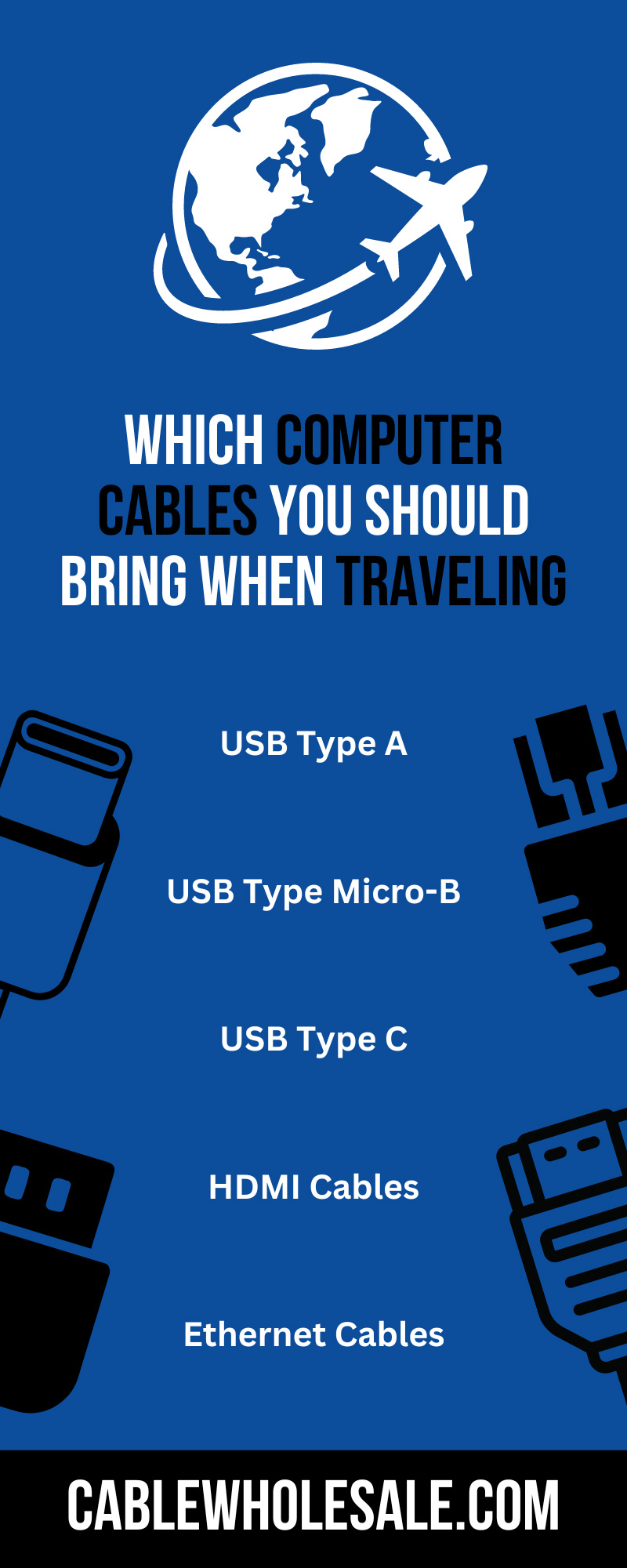
In an increasingly digital world, the necessity of staying connected—especially while traveling—is a valuable concept to understand. It’s important to carry the right computer cables for quality connections; however, knowing which cables to pack may feel daunting considering the plethora of devices. Read on to discover which computer cables you should bring when traveling to ensure a lack of connection doesn’t interrupt your journey.
USB Type A
USB Type A cables are the quintessential connectors in the realm of digital technology, renowned for their ubiquity and versatility across a myriad of devices. These cables serve as the backbone for connecting peripheral devices such as keyboards, mice, external hard drives, and flash drives to computers and laptops. USB Type A is compatible with an extensive range of devices, making it an indispensable tool in the tech arsenal of professionals and casual users alike.
Type A is compatible with USB 2.0, 3.0. and 3.1, ensuring it has the capability of making numerous connections with different connectors and devices using older and newer technology. Type A to Micro-B is one of the most common connections for smaller devices and support interfaces up to 3.1 while providing backwards compatibility. Other types of connections in recent USB specifications, such as USB Type A to Type C, are advantageous in technology that requires faster data transfer and higher power supply.
The Benefits of USB Type A When Traveling
One of the most compelling advantages of integrating a USB Type-A cable into your travel gear is its unparalleled compatibility and reliability. This cable type acts as a universal key, unlocking access to various electronic devices and peripherals, thereby minimizing the need for multiple device-specific cables.
Whether presenting at international conferences or simply catching up on work in a remote location, a USB Type-A cable ensures you make a quick connection. Its durable design also means it withstands the rigors of travel, offering a dependable solution to your connectivity needs.
USB Type Micro-B
The USB Type Micro-B cable is a pivotal component in the ecosystem of mobile and portable devices, catering to smartphones, tablets, cameras, and portable hard drives. This slender and durable connector is compatible with USB 2.0 and 3.0 making it an excellent choice for devices requiring efficient power charging and rapid data transfer rates.
However, it’s important to note that the design of USB 3.0 Type Micro-B is different compared to the 2.0 version. The additional 5-pin plug provides a 10-pin connection, making devices with USB 2.0 Type Micro-B backwards compatible with USB 3.0. These variations in design offer connections using recent versions of USB such Type Micro-B to C.
The Benefits of USB Type Micro-B When Traveling
The USB Type Micro-B cable renders itself indispensable to the modern traveler by facilitating seamless connectivity and rapid data synchronization for a spectrum of portable devices. Its compact form factor combined with the hallmark of durability makes it supremely suited for the challenges and unpredictability of travel.
While traveling, having fully charged devices is essential for ensuring you can make an emergency call or capture a quick shot with your camera. Traveling with a Type Micro-B allows you to use portable power banks to energize your devices during your adventures.
Communication between devices is also essential, thanks to the USB Micro-B’s data transfer rate of 480 Mbps, which is a suitable speed for smaller devices. Including a USB Micro-B cable in your tech repertoire, whether as a professional or casual traveler, amplifies your on-the-go efficiency and access to power and data transfer.
USB Type C
The advent of USB Type C marked a revolutionary stride in digital connectivity, heralding a new era of convenience and efficiency. Characterized by its reversible connector design, this cutting-edge technology eliminates the perennial challenge of orientation, allowing for a hassle-free connection every time.
USB Type C cables are compatible with a wide range of USB standards including 2.0, 3.0 with 5-10 Gbps transfer rates, 3.1, 3.2, and USB4. These cables facilitate high-speed data transfer of up to 10 Gbps and power delivery to the latest smartphones, laptops, tablets, and smartwatches. Type C connectors are compatible with lightning cables via adapter, extending the exceptional performance to Apple and Android devices. This versatility consolidates multiple cables into a single, universal solution and supports the rapid charging of devices, significantly reducing downtime and enhancing productivity.
The Benefits of USB Type C When Traveling
The inclusion of a USB Type C cable in your travel essentials underscores a commitment to efficiency, versatility, and forward-thinking readiness. Its ability to deliver fast-charging capabilities and superior data transfer speeds epitomizes the pinnacle of modern connectivity, catering to the demanding needs of today’s tech-reliant traveler.
Whether you need fast charging or swift data transfer before an important meeting, the USB-C is a go-to computer cable to bring while traveling. The USB Type C cable symbolizes adaptability. It is compatible with an array of devices, from smartphones to laptops, ensuring you have what you need for seamless connectivity.
HDMI Cables
High-Definition Multimedia Interface (HDMI) cables became the gold standard for transmitting high-definition audio and video signals between various devices and display systems. Their ability to deliver crisp, clear, and vibrant multimedia content in a unified stream distinguishes HDMI cables as the preferred choice for numerous occasions.
These versatile cables connect to devices such as laptops, gaming consoles, digital cameras, and modern televisions and monitors, ensuring a high-quality digital connection. Certain HDMI cables support up to 4K resolution, and ultra high-speed cables support up to 8K. Many displays are enhanced thanks to these cables, making them popular for those looking to stream or game on the go.
The Benefits of HDMI Cables When Traveling
The pivotal advantage of incorporating an HDMI cable into your travel inventory is the unparalleled quality of multimedia transmission it provides. This indispensable tool ensures that professionals convey their messages with crystal-clear visuals and crisp audio wherever they stream their video calls.
Travelers looking to unwind will enjoy cinematic excellence from the comfort of their hotel room, connecting personal devices to high-definition screens for an immersive viewing experience. HDMI cables stand out for their superior performance across digital environments, making them a critical component for anyone seeking to elevate their digital interaction.
Ethernet Cables
Ethernet cables reign supreme in wired network connectivity, providing the most stable and high-speed Internet connection possible. These cables, designed to connect devices to local area networks (LANs), are essential for travelers needing reliable, uninterrupted access to the Internet.
Ethernet cables are compatible with various devices, including laptops, desktop computers, gaming consoles, smart TVs, and even modern smartphones and tablets with the appropriate adapter. This versatility ensures that, regardless of your device, a high-quality Ethernet connection significantly boosts your online efficiency and security.
The Benefits of Ethernet Cables When Traveling
For travelers, the essence of Ethernet cables lies in their capability to enable a steadfast Internet connection, offering unparalleled reliability and speed that Wi-Fi cannot match. When you are in a new location, these networking cables offer a sanctuary of connectivity, ensuring your online interactions are swift and secure.
This tangible advantage translates into uninterrupted video conferencing, efficient large-scale data transfers, and seamless access to online resources. Include a high-quality Ethernet cable such as a Cat6a or 8 in your travel gear to maintain peak productivity and reliable connection as you travel. The high transfer speeds of up to 10 Gbps and 40 Gbps, respectively, ensure you’ll easily download and upload content to the Internet.




